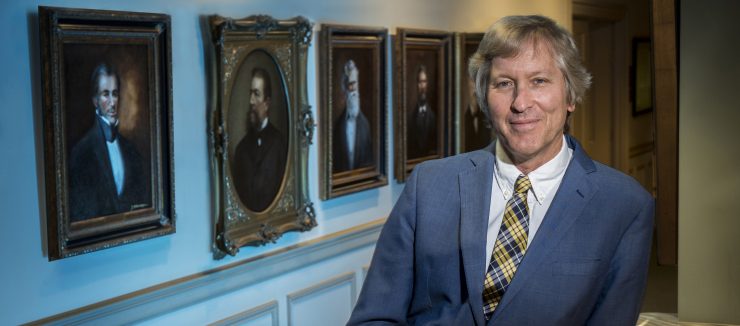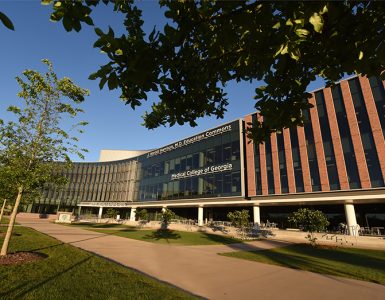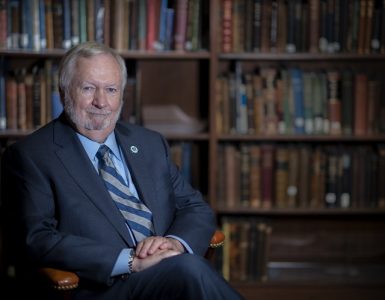In his defining book Good to Great, which remains one of my favorite business strategy reads of all time, author Jim Collins talks about the Flywheel Effect. In describing it, he explains that “No matter how dramatic the end result, good-to great transformations never happen in one fell swoop. In building a great company… there is no single defining action, no grand program, no one killer innovation, no solitary lucky break, no miracle moment. Rather, the process resembles relentlessly pushing a giant, heavy flywheel, turn upon turn, building momentum until a point of breakthrough, and beyond.”
I can’t think of a better way to describe the last year at MCG. Turn upon turn, we have been working toward several important milestones – breakthroughs and beyond. It has truly been a time of unprecedented change and growth at the state’s only public medical school.
Our first breakthrough came in May, when we received funding approval for what will be our third four-year campus, in Savannah, in partnership with Georgia Southern University. This new campus will allow us to grow our class size, already one of the nation’s largest, from 264 to 304 students per class — with the first class set to enroll in July. In the coming months, $1.7 million in renovations to the GSU’s Armstrong Campus — fortuitously located just down the street from St. Joseph’s/Candler, a longtime clinical partner —will be complete, making the Augusta University/Medical College of Georgia- Georgia Southern Partnership campus a reality.
We could not have pushed the flywheel alone — not without the funding being included in the FY 2024 budget passed by the Georgia General Assembly and signed by Governor Brian Kemp; the backing from University System of Georgia Chancellor Sonny Perdue, the entire Board of Regents and AU President Brooks Keel; the unwavering assistance of the entire legislature, specifically House Speaker Jon Burns and state Rep. Butch Parrish; or the great partnership of Georgia Southern University, specifically President Kyle Marrero. I would also be remiss to not acknowledge the longtime support of St. Joseph’s/Candler Health System, particularly CEO Paul Hinchey. They have helped educate MCG students in that corner of the state for over a decade and I know their commitment will only grow with this new partnership.
Each of them understands that as the public medical school for a state that consistently ranks near the bottom in the number of active physicians, and in turn, near the top in poor health outcomes, it is our responsibility and commitment to produce more doctors for Georgia. This growth in our class size is an important part of fulfilling that critical mission. The momentum for the growth of your medical school only continued throughout the summer when we received word from our accrediting body, the Liaison Committee on Medical Education, in July that our plans to expand in Savannah met their rigorous standards; and then again in August, when Dr. Elizabeth Gray, who has led the Savannah location of our Southeast Regional Campus since 2020, was appointed founding campus dean. (See page 9).
August brought another breakthrough as well, with the announcement that Wellstar Health System and Augusta University Health System are now a unified system, known locally as Wellstar MCG Health. The public signing on Aug. 30 was truly a historical moment for health care in our state. The new system combines the strengths of Wellstar, a large non-profit health system that provides care for 1 in 6 people in Georgia, the Augusta University Health System, and your nearly 200-year-old medical school. As Wellstar CEO Candice Saunders rightly said that day, this was the realization of a longtime vision. MCG has had medical students rotating at Wellstar Kennestone for over six years — in fact, 17 of them are currently completing their clinical training at Wellstar Kennestone in Marietta now, with more set to join them in January. We may have a new name, but it represents generations of excellent patient care, innovation, research and education.
In addition to helping financially stabilize and grow our health system and medical school, Wellstar has committed to investing in facilities and infrastructure in Augusta. They’re also going to strengthen collaborations with rural hospitals, provide greater access to clinical innovations in clinical care and expand digital and telehealth services — something that falls right in line with the mission of our MCG Center for Telehealth, which has long been working to connect the resources of this medical school and its teaching hospital to those who need them, no matter their location.
We also hope that, with LCME approval, we can eventually establish a permanent regional clinical campus – much like those we already have in Albany, Rome/Dalton and Savannah/Brunswick — in Atlanta in partnership with Wellstar. And our new partners have 265 graduate medical education slots across the state — in primary and subspecialty care — that already train MCG graduates. I can imagine that number will only multiply and help keep more Georgia-trained physicians in our state.
I must again extend my thanks to Gov. Kemp, the University System of Georgia Board of Regents and Chancellor Perdue, leadership at both health systems and to all of you for your belief in, and endless support of, your medical school. While there is still much work to be done, I do believe some of our greatest days, and biggest breakthroughs, are ahead.
All my best,

David C. Hess, MD
Dean, Medical College of Georgia
Executive Vice President for Medical Affairs
and Integration, Augusta University
Presidential Distinguished Chair









